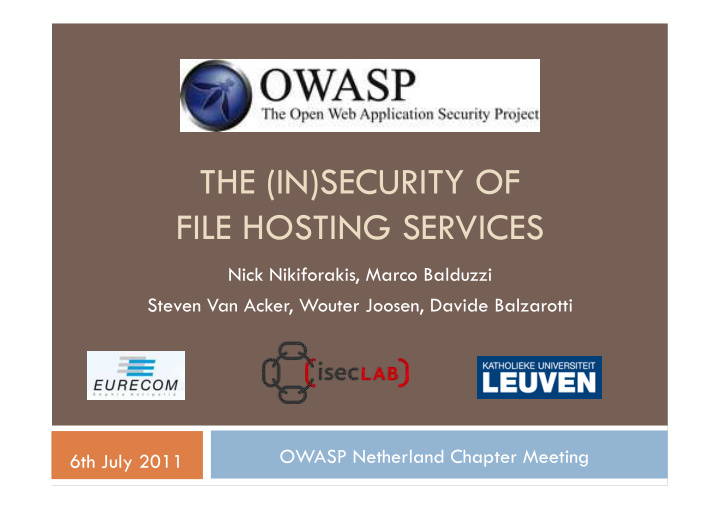



THE (IN)SECURITY OF FILE HOSTING SERVICES Nick Nikiforakis, Marco Balduzzi Steven Van Acker, Wouter Joosen, Davide Balzarotti OWASP Netherland Chapter Meeting 6th July 2011
Sharing is caring Internet expanding More users More Web services More Web technologies Users need to share files P2P is not always the answer Emails?
Sharing Services Broad selection of services with a wide variety of applications Accessible through the Web from anywhere No software-bloating for users More free software due to a different way of making profit
Bad news… A user’s data is now located somewhere else: Privacy Availability Integrity • Sad story (T-Mobile & Microsoft): – 2009: “personal information stored on your device--such as contacts, calendar entries, to-do lists or photos--that is no longer on your Sidekick almost certainly has been lost as a result of a server failure at Microsoft/Danger”
File Hosting Services Cloud-storage for the masses Share files with other users Security through obscurity access-control Sharing personal documents as well as pirated files
Lifecycle of a file Alice decides to shares some digital content (file) through a FHS FHS received the file, stores it on its Cloud and generates an identifier which it: binds with the uploaded file i. returns to the user in a URI form: ii. http://www.easy-share.com/1916472551/ noctambus.pdf URI is shared depending on the nature of the uploaded file
File Identifier & Privacy The identifier (ID) is used to enforce access-control in a security-through-obscurity way ID == access to file FHS are typically not-searchable ID acts as a shared secret between a FHS and each user’s files Non-owners should not be able to “guess” this secret
100 FHSs: How many privacy-aware? We studied 100 FHSs to discover, among others, the way they generate unique “secret” identifiers Uploading files, recording the given ID and comparing Removed 12 that had search/browse capabilities
Sequential IDs 34/88 FHS were generating sequential identifiers numeric, or alphanumerical 20/34 did not append any other non-guessable information e.g. filename or secondary ID E.g. http://vulnerable.com/9996 http://vulnerable.com/9997 http://vulnerable.com/9998
Sequential IDs Designed a crawler for the 20 sequential FHS Run for 30 days Random delays to limit bandwidth and blacklisting Scraping only the filenames and sizes (privacy) Results: > 310,000 file records
Finding private files… Depending on the nature of a file, it will be shared in different ways Exploit the ubiquity of search-engine crawlers to characterize a file as private or public. Given a filename 0 search results -> Private
Private Files Results Using Bing: 54.16% of files returned 0 search results Rough approximation of private files due to close pirate communities Filetype #Private documents Images (JPG, GIF, BMP) 27,711 Archives (ZIP) 13,354 Portable Document Format 7,137 MS Office Word 3,686 MS Office Excel Sheets 1,182 MS Office PowerPoint 967
Identifiers of 100 FHSs (summary)
Non-Sequential IDs 54 FHSs adopt non-sequential identifiers len(ID)
Non-Sequential IDs 54 FHSs adopt non-sequential identifiers len(C_SET)
Random but short Brute-force short random identifiers Length Charset #Tries #Files Found 6 Numeric 617,169 728 6 Alphanumeric 526,650 586 8 Numeric 920,631 332
Design & Implementation errors Security audit of a popular FHS software product Used in 13% of FHSs Directory traversal vulnerability De-randomization attack for deletion code Report-link contained the first 10 characters of the 14- charater delete code 16^14 -> 16^4 combinations
Status… File hosting services are not privacy-aware Sequential identifiers Weak non-sequential identifiers Bugs in their source code Do attackers know about this? How do we found out?
Honeypot experiment Honeyfiles promising valuable content Phished_paypal_details.html � Paypal_account_gen.exe � Sniffed_email1.doc � Each file connects back to our monitor server when opened <img/> in HTML files embedded HTML in doc files TCP socket in executables Attempt to open page in pdf files
Carding forum One of the decoy files contained valid credentials for our fake forum card3rz_reg_details.html � Fake underground carding community card3rz.co.cc Reasons: Hide our monitors i. Do attackers use data that they find in illegally ii. obtained files?
NOW
Honeypot experiment: results Monitoring sequential FHSs for 30 days 275 honeyfiles accesses More than 80 unique IP addresses 7 different sequential FHSs 1 had a catalogue functionality 2 had a search functionality 4 had neither! Accesses from all around the world
Geo-location of the bad-guys
HoneyFiles results Download ratio of each file: Claimed content Download ratio Credentials to PayPal accounts 40.36% Credentials for card3rz.co.cc 21.81% PayPal account Generator 17.45% Leaked customer list 9.09% Sniffed email 6.81% List of emails for spamming purposes 5.09%
card3rz.co.cc results 93 successful logins 43 different IP addresses 32% came back at a later time Attacks against the monitor and the login-form SQL-injection & file-inclusion attacks Attackers do in-fact use data from illegally obtained files
Status… File hosting services are vulnerable Sequential identifiers Weak non-sequential identifiers Bugs in their source code Attackers are abusing them They are using the data found in other user’s files
SecureFS A client must protect himself Encryption is a good way Do people know how to? If they do know, does their OS assist them? SecureFS Encryption to protect a user’s data Steganography to mislead potential attackers Project site: http://www.securitee.org/sfs/
SecureFS Browser-plugin monitoring uploads and downloads Protects uploads on-the-fly important.doc SFS_HDR ENC(important.doc,RND_KEY) ZIP(FAKE) Browser-plugin monitoring uploads and downloads Rewrites download links to include the random key http://unsafefhs.com/12345 http://unsafefhs.com/12345/sfs_key/[RND_KEY]
Conclusion Large percentage of FHSs fail to provide the user with adequate privacy Hundreds of thousands of files ready to be misused Attackers know & exploit this fact A user must protect himself: SecureFS
Questions
Recommend
More recommend